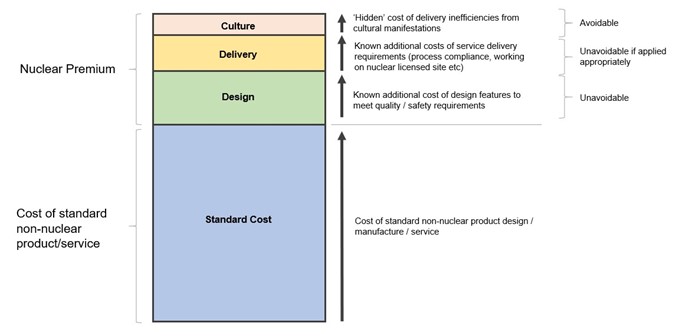Association for Project Management
|
|
Three ways culture impacts project delivery performance in the nuclear industry, and what we can do about it
Blog posted by: Connor Deehan, 7 May 2021.

We believe there are hidden inefficiencies in the often forgotten and underestimated aspects of delivering complex projects and programmes in the nuclear industry. We believe that these inefficiencies can be reduced by unleashing the potential of project teams by focusing on building the right culture.
We define culture as the underlying assumptions, values and beliefs in an organisation - which are manifested in people’s mindsets and therefore their behaviours and ultimately the way things get done. All organisations exhibit a culture in some form, and equally so do project teams – especially large teams that exist for many years (which is the case for many complex nuclear projects).
We contend that some inefficiencies exist as a result of certain cultural manifestations that is present in most nuclear organisations. We explore these below and highlight some techniques that can be adopted to minimise their negative impacts, whilst leveraging their positive effects.
Culture in the context of nuclear project delivery
The nuclear industry is quite rightly safety conscious and compliancy focused. Without this focus, it would not have the admirable safety record that sets it apart from many other industrial sectors (according to compiled safety data, nuclear power is an order of magnitude safer – as measured by deaths – than oil, hydro power, biomass, natural gas and coal). There is a perceived tension between doing things the right way, i.e. ensuring quality and safety, with doing things quickly and efficiently. We believe this tension is misplaced, in fact the opposite is true. For instance, in high hazard nuclear decommissioning projects, finishing earlier can have the effect of reducing the hazard earlier – a positive outcome from a safety perspective. In addition, the characteristics of a good safety culture as defined by the Institute of Nuclear Power Operations (INPO)1, are also good principles of what we could call a good ‘delivery culture’:
- Personal accountability
- Questioning attitude
- Effective safety communications
- Leadership safety values and actions
- Decision making
- Respectful work environment
- Continuous learning
- Problem identification and resolution
- Environment for raising concerns
- Work processes
Nevertheless, we argue that the nuclear industry’s relentless – and entirely appropriate – focus on safety has had other consequences that are less understood in the context of project delivery. These centre around two key cultural manifestations: conservatism and high compliance. Conservatism can lead to aversion to risk, and high compliance can lead to blind compliance – where individuals follow norms without ever challenging them. It is important to note here that we are referring to project risk (a variable, yet expected element of any project), not physical risk to personnel (which should never be compromised).
We contend that a culture exhibiting conservatism and high compliance impacts project and programme delivery in the following ways:
- Uncomfortable in uncertainty. Teams don’t like taking project uncertainty in project delivery and therefore tend to default to previous ways of work and industry norms. Planning into detail, even far into the future is typically perceived as reducing risk, however nuclear projects are rarely the same (especially in decommissioning) and planning for the unknown is very difficult. Planning for uncertainty, adapting delivery methods and taking a more flexible approach can help to achieve success in project delivery.
- Inhibits innovation. Innovation requires a mindset of challenging the norms and thinking of how to do something differently. Blind compliance reduces an individual’s ability to think differently, how to do different and how to change the way things are done. Innovation is not invention – and therefore innovation is about how we embed something new. Even with new technology and invention, if we don’t foster a culture of innovation then the ways of working will not change and efficiencies won’t be unlocked.
- Inhibits continuous improvement. Blind compliance with process leading to inefficient working practices and a lack of ‘challenge to status quo’. We argue that we can strive for delivery improvement without being at the expense of safety or quality, if we enable and create the safe space for teams to challenge how we are doing things.
Whilst we recognise that the impact of culture on project and programme delivery is complex and broader than our list above, we are interested on these ‘inefficiency traps’ as they can lead to increased costs. This is important as cost competitiveness is a critical issue across the nuclear sector currently, whether new build or decommissioning, as both have committed to significant cost reductions as part of the 2018 nuclear sector deal.
The ‘nuclear premium’ and its link to culture
The concept of a ‘nuclear [cost] premium’ is anecdotally well known within the nuclear industry’s cadre of project and programme leaders and procurement professionals. The nuclear premium refers to the phenomenon whereby the cost of an output (goods and services, or delivery of project and programmes) within the nuclear industry costs more than it would normally do in an adjacent non-nuclear yet industrialised sector. The nuclear premium is made up of three elements (see figure below):
- Design. Costs due to functional requirements that are needed meet stringent safety and quality requirements. Examples include additional systems to ensure redundancy for safety critical components. These costs are unavoidable and accepted.
- Delivery. Costs due to meeting nuclear clients’ service delivery needs. There are many of these, examples include: enhanced project governance/gated processes, compliance with processes not required by non-nuclear industrial buyers and costs of physically working on a nuclear licensed site. When applied appropriately these are unavoidable.
- Culture. Additional costs due to inefficiencies built into the project/programme life cycle, as we explain above. These costs are avoidable.

If we can deliver projects and programmes in the nuclear industry more efficiently, by unblocking unnecessary behavioural inhibitions whilst maintaining the necessary ones, the industry will become more competitive, and safer.
What can we do?
Being conscious of the nuclear premium, the nuclear culture, and our own mindsets is the first step in address the inefficiencies it brings. We want to raise awareness of this as a potential inhibitor to the industry reaching its potential from an efficient project and programme delivery performance perspective, and look forward to debating the different views.
It is important to note that we are not advocating for a relaxation of the regulatory regime – far from it. We are advocating that the industry should celebrate the positive impacts from the unique culture that it has so successfully fostered, but also become aware of the downsides of this culture.
At the industry level, we recommend that key stakeholders (project/programme management, engineering, regulators, procurement and executives) come together to address the problem. We believe a concerted effort will be required to move mindsets, but that the payoff is worth the effort. Below we recommend some practical approaches that project leaders can use right now to improve the creativity, innovation, efficiency and positivity amongst their teams:
- Identify explicitly the mindsets that need to change, and the mindsets that need to be created in your team for your project to be successfully executed.
- Measure the level of maturity in your team around the high-performance mindsets that you want to create more of.
- Create transformational conversations about these mindsets, to re-wire the way people think and behave and focus the team on how they might improve to deliver and perform at greater pace.
- Embed transformational conversations into the operational ‘day job’ for your team, so they become a valued routine that helps your team drive higher performance by greater focus on behaviours – how we get the work done, as well as what we need to do. Embed and operationalise, in much the same way as the ‘safety share’ is a part of many organisations’ DNA.
- Focus your team on trialling improvement ideas that make a tangible improvement on your performance (for example: the time it takes to complete tasks, avoiding duplication, getting rid of reporting for reporting’s sake). Quantity the benefit of these small wins to build confidence in your team in the changes that you make to your ways of working.
Don’t miss our webinar
We will be running a webinar in June 2021 where we will be exploring this in more detail and hearing from a range of culture experts, as well as nuclear industry practitioners.
This blog post has been produced by the Nuclear Project Management Specific Interest Group (SIG), a joint initiative between the Association for Project Management and the Nuclear Institute. The group is seeking to improving the capability and performance of project, programme and portfolio management within the nuclear industry, with a view to enhancing the competitiveness of the nuclear industry. A core part of the SIG’s strategy is to seek, identify, study and solve key issues pertaining to the successful delivery of projects, programme and portfolios that are present within the wider nuclear sector and organisations (both public and private) acting within it.
If you would like to find out more, please visit our website or email us on pm.sig@nuclearinst.com. Read our previous blog on why the nuclear industry needs to transform how it delivers projects here.
1 Pocket Guide to INPO 12-012: Traits of a Healthy Nuclear Safety Culture Rev 1
About the Aurthor
This blog was co-written by Connor Deehan and Tom Eastup
Tom Eastup is a management consultant and qualified project, programme, portfolio management (P3M) professional. Through his work at innovation and transformation company PA Consulting, he helps energy and utilities organisations create, deliver and realise opportunities at the intersection between strategy, innovation and technology. His focus is on supporting his clients to design and deliver their complex business transformation initiatives, and ultimately realise their intended benefits. Tom believes that nuclear will be a key contributor to Net Zero, and through his role as Chair of the APM/NI Nuclear PM SIG, is actively supporting the industry to maximise its delivery performance and competitiveness.
Original article link: https://www.apm.org.uk/blog/three-ways-culture-impacts-project-delivery-performance-in-the-nuclear-industry-and-what-we-can-do-about-it/
- RESOURCES
- MEMBERSHIP
- CHARTERED STANDARD
- QUALIFICATIONS AND TRAINING
- JOBS AND CAREERS
- NEWS AND OPINION
- COMMUNITY
- EVENTS
- BOOKS


